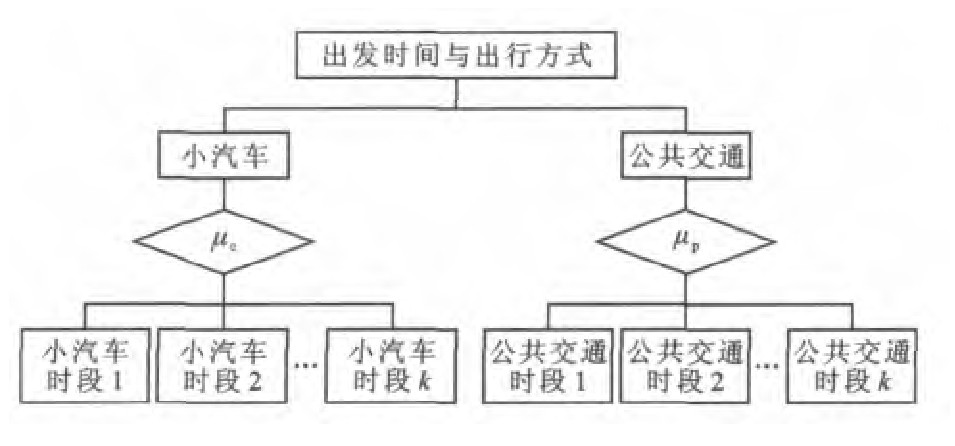-
摘要: 基于随机效用最大化理论, 选取出行者特征、行程特性与出行方式服务水平作为效用变量, 以出行方式与出发时间作为选择肢, 构建了出发时间位于下层与出行方式位于下层的2种居民出行NL模型。分析了北京市居民出行样本数据, 并模拟了在早高峰时段对小汽车出行收取费用时, 小汽车出行者出行行为的变化。计算结果表明: 与传统MNL模型相比, NL模型具有更好的统计学特征, 调整后的拟合优度由0.338增大至0.404;在2种NL模型中, 出发时间位于下层的结构对样本数据的适应性更强; 当早高峰时段小汽车出行收取费用为5元时, 72.6%的小汽车出行者坚持原有出行方式与出发时间, 22.4%的小汽车出行者坚持小汽车方式, 但会改变出发时间, 4.8%的小汽车出行者改用公共交通方式, 但出发时间不变, 仅0.2%的小汽车出行者同时改变出行方式与出发时间; 当收取费用为10元时, 51.7%的小汽车出行者坚持原有出行方式与出发时间, 40.4%的小汽车出行者坚持小汽车方式, 但会改变出发时间, 7.9%的小汽车出行者改用公共交通方式, 但出发时间不变; 当收取费用为20元时, 27.5%的小汽车出行者坚持原有出行方式与出发时间, 60.6%的小汽车出行者坚持小汽车方式, 但会改变出发时间, 11.9%的小汽车出行者改用公共交通方式, 但出发时间不变。Abstract: Based on the maximum random utility theory, traveler characteristic, travel characteristic and the service level of travel mode were taken as utility variables, travel mode and departure time were taken as alternative parts, and two nested logit(NL) models were built, one structure with departure time located in lower layer and another structure with travel mode located in lower layer.The sample data of resident travel in Beijing City were analyzed, and the travel behavior changes of car travelers were simulated when different car travel costs were charged in morning peak period.Calculation result shows that compared with traditional MNL model, there is better statistic characteristic in NL model.After adjustment, the goodness of fit increases from 0.338 to 0.404.In the two NL models, the structure with departure time located in lower layer has stronger adaptability on sample data than the structure with travel mode located in lower layer.While car travel cost in morning peak period is 5 yuan, 72.6% of car travelers will still insist on original travel mode and departure time, 22.4% of car travelers will still insist on original travel mode, but will change departure times, 4.8% of car travelers will turn to public transit, but will still insist on original departure time, and only 0.2% of car travelers will change travel mode and departure time simultaneously.While car travel cost in morning peak period is 10 yuan, 51.7% of car travelers will still insist on original travel mode and departure time, 40.4% of car traveler will still insist on original travel mode, but will change departure times, and only 7.9% of car travelers will turn to public transit, but will still insist on original departure time.While car travel cost in morning peak period is 20 yuan, 27.5% of car travelers will still insist on original travel mode and departure time, 60.6% of car travelers will still insist on original travel mode, but will change departure times, and only 11.9% of car travelers will turn to public transit, but will still insist on original departure time.
-
Key words:
- traffic demand management /
- travel mode /
- departure time /
- combined selection /
- NL model /
- MNL model /
- utility variable /
- peak charge
-
表 1 效用变量
Table 1. Utility variables

表 2 方法1计算结果
Table 2. Calculation results of method 1

表 3 方法2计算结果
Table 3. Calculation results of method 2

表 4 工况1出行方式和出发时间
Table 4. Travel modes and departure times of section 1

表 5 工况2出行方式和出发时间
Table 5. Travel modes and departure times of section 2

表 6 工况3出行方式和出发时间
Table 6. Travel modes and departure times of section 3

-
[1] PALMA A D, ROCHAT D. Mode choice for trips to work in Geneva: an empirical analysis[J]. Journal of Transport Geography, 2000, 8(1): 43-51. doi: 10.1016/S0966-6923(99)00026-5 [2] BHARAT P, BHATTE O I. Errors in variables in multino-mial choice modeling: a simulation study applied to a multino-mial logit model of travel mode choice[J]. Transport Policy, 2011, 18(2): 326-335. doi: 10.1016/j.tranpol.2010.10.002 [3] LIMTANAKOOL N, DIJST M, SCHWANEN T. The influ-ence of socioeconomic characteristics, land use and travel time considerations on mode choice for medium and longer-distance trips[J]. Journal of Transport Geography, 2006, 14(5): 327-341. doi: 10.1016/j.jtrangeo.2005.06.004 [4] 许铁, 高林杰, 景鹏, 等. 基于PSO-SVM的居民出行方式预测模型[J]. 交通运输系统工程与信息, 2011, 11(5): 155-161. doi: 10.3969/j.issn.1009-6744.2011.05.023XU Tie, GAO Lin-jie, JING Peng, et al. Prediction model of residents'trip mode based on PSO-SVM[J]. Journal of Transportation Systems Engineering and Information Tech-nology, 2011, 11(5): 155-161. (in Chinese). doi: 10.3969/j.issn.1009-6744.2011.05.023 [5] 姚荣涵. 基于最大信息熵的居民出行分布模型研究[D]. 长春: 吉林大学, 2004.YAO Rong-han. Study on inhabitant trip distraibution model based on maximum information entropy[D]. Changchun: Jilin University, 2004. (in Chinese). [6] 刘炳恩, 隽志才, 李艳玲, 等. 居民出行方式选择非集计模型的建立[J]. 公路交通科技, 2008, 25(5): 116-120. doi: 10.3969/j.issn.1002-0268.2008.05.022LIU Bing-en, JUAN Zhi-cai, LI Yan-ling, et al. Develop-ment of a multinomial logit model for travel mode choice of residents[J]. Journal of Highway and Transportation Researchand Development, 2008, 25(5): 116-120. (in Chinese). doi: 10.3969/j.issn.1002-0268.2008.05.022 [7] LEMP J D, KOCKELMEN K M, DAMIEN P. The continu-ous cross-nested logit model: formulation and application for departure time choice[J]. Transportation Research Part B: Methodological, 2010, 44(5): 646-661. doi: 10.1016/j.trb.2010.03.001 [8] SALEH W, FARRELL S. Implications of congestion char-ging for departure time choice: work and non-work schedule flexibility[J]. Transportation Research Part A: Policy and Practice, 2005, 39(9): 773-791. [9] OZBAY K, YANMAZ-TUZEL O. Valuation of travel time and departure time choice in the presence of time-of-day pri-cing[J]. Transportation Research Part A: Policy and Prac-tice, 2008, 42(4): 577-590. doi: 10.1016/j.tra.2007.12.002 [10] 宗芳, 隽志才, 张慧永. 基于活动的日活动计划模型[J]. 吉林大学学报: 工学版, 2007, 37(6): 1294-1299. https://www.cnki.com.cn/Article/CJFDTOTAL-JLGY200706014.htmZONG Fang, JUAN Zhi-cai, ZHANG Hui-yong. Activity-based full day activity pattern model[J]. Journal of Jilin Uni-versity: Engineering and Technology Edition, 2007, 37(6): 1294-1299. (in Chinese). https://www.cnki.com.cn/Article/CJFDTOTAL-JLGY200706014.htm [11] BHAT C R. Analysis of travel mode and departure time choice for urban shopping trips[J]. Transportation Research Part B: Methodological, 1998, 32(6): 361-371. doi: 10.1016/S0191-2615(98)00004-6 [12] DE JONG G, DALY A, PIETERS M, et al. A model for time of day and mode choice using error components logit[J]. Transportation Research Part E: Logistics and Transporta-tion Review, 2003, 39(3): 245-268. doi: 10.1016/S1366-5545(02)00037-6 [13] WEN C H, KOPPELMAN F S. The generalized nested logit model[J]. Transportation Research Part B: Methodological, 2001, 35(7): 627-671. doi: 10.1016/S0191-2615(00)00045-X [14] BEKHOR S, PRASHKER J N. GEV-based destination choice models that account for unobserved similarities among alternatives[J]. Transportation Research Part B: Methodo-logical, 2008, 42(3): 243-262. doi: 10.1016/j.trb.2007.08.003 [15] PINJARI A R. Generalized extreme value-based errorstruc-tures for multiple discrete-continuous choice models[J]. Transportation Research Part B: Methodological, 2011, 45(5): 474-489. [16] BIERLAIRE M. A theoretical analysis of the cross-nested logit model[J]. Annals of Operation Research, 2006, 144(1): 287-300. doi: 10.1007/s10479-006-0015-x [17] PAPOLA A. Some developments on the cross-nested logit model[J]. Transportation Research Part B: Methodological, 2004, 38(9): 833-851. doi: 10.1016/j.trb.2003.11.001 [18] 胡华, 腾靖, 高云峰, 等. 多模式公交信息服务条件下的出行方式选择行为研究[J]. 中国公路学报, 2009, 22(2): 87-92. https://www.cnki.com.cn/Article/CJFDTOTAL-ZGGL200902015.htmHU Hua, TENG Jing, GAO Yun-feng, et al. Research on travel mode choice behavior under integrated multi-modal transit information service[J]. China Journal of Highway and Transport, 2009, 22(2): 87-92. (in Chinese). https://www.cnki.com.cn/Article/CJFDTOTAL-ZGGL200902015.htm [19] 刘浩学, 冯忠祥, 赵炜华, 等. 中国农村人口活动出行距离分布模型[J]. 长安大学学报: 自然科学版, 2010, 30(6): 68-71. https://www.cnki.com.cn/Article/CJFDTOTAL-XAGL201006015.htmLIU Hao-xue, FENG Zhong-xiang, ZHAO Wei-hua, et al. Trip distance distribution mode of Chinese rural population[J]. Journal of Chang'an University: Natural Science Edition, 2010, 30(6): 68-71. (in Chinese). https://www.cnki.com.cn/Article/CJFDTOTAL-XAGL201006015.htm [20] 曲大义, 于仲臣, 庄劲松, 等. 苏州市居民出行特征分析及交通发展对策研究[J]. 东南大学学报: 自然科学版, 2001, 31(3): 118-123. https://www.cnki.com.cn/Article/CJFDTOTAL-DNDX200103027.htmQU Da-yi, YU Zhong-chen, ZHUANG Jin-song, et al. Analysis on the resident trip characteristics and study on the transport development policies in Suzhou[J]. Journal of Southeast University: Natural Science Edition, 2001, 31(3): 118-123. (in Chinese). https://www.cnki.com.cn/Article/CJFDTOTAL-DNDX200103027.htm [21] 冯忠祥, 刘浩学, 张景峰. 农村人口出行方式选择模型[J]. 交通运输工程学报, 2010, 10(3): 77-83. http://transport.chd.edu.cn/article/id/201003014FENG Zhong-xiang, LIU Hao-xue, ZHANG Jing-feng. Selection model of trip modes for rural population[J]. Journal of Traffic and Transportation Engineering, 2010, 10(3): 77-83. (in Chinese). http://transport.chd.edu.cn/article/id/201003014 [22] LAHIRI K, GAO Jian. Bayesian analysis of nested logit model by Markov chain Monte Carlo[J]. Journal of Econo-metrics, 2002, 111(1): 103-133. -





 下载:
下载:




